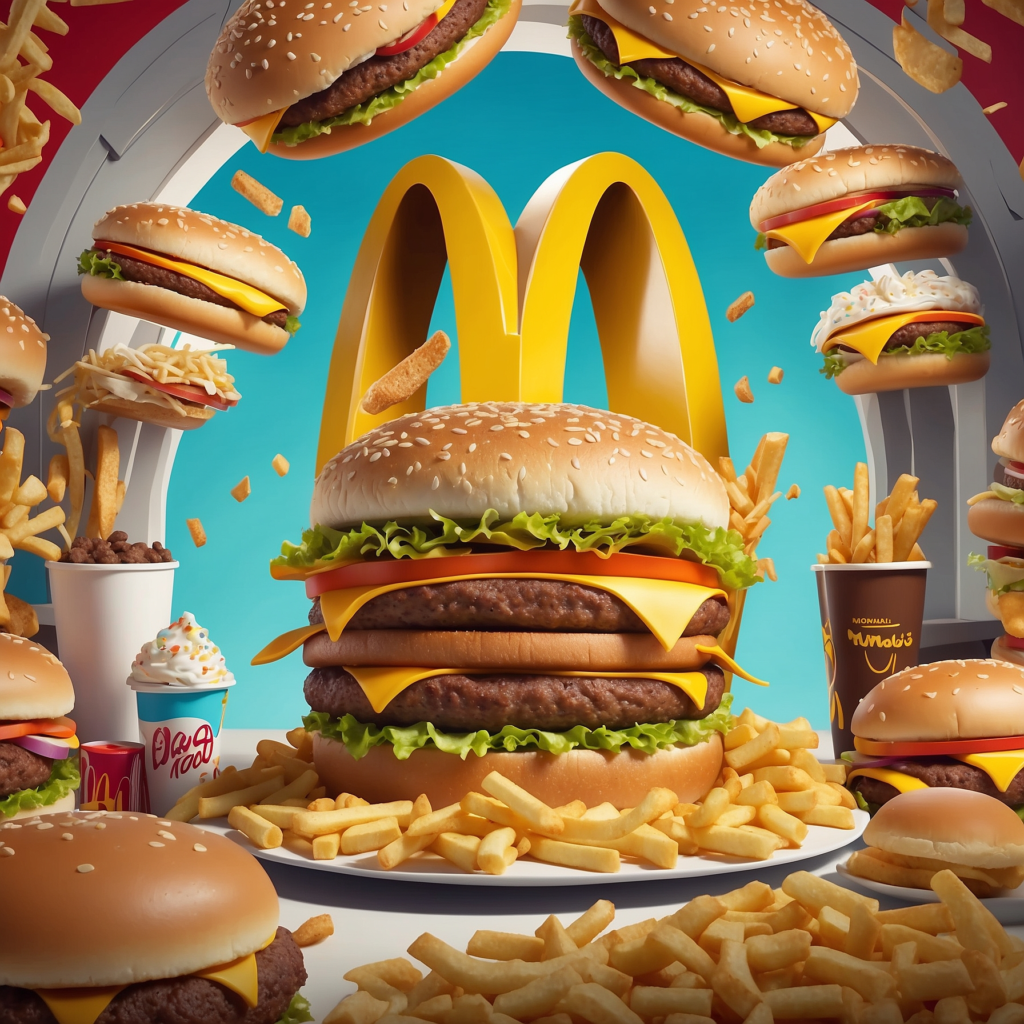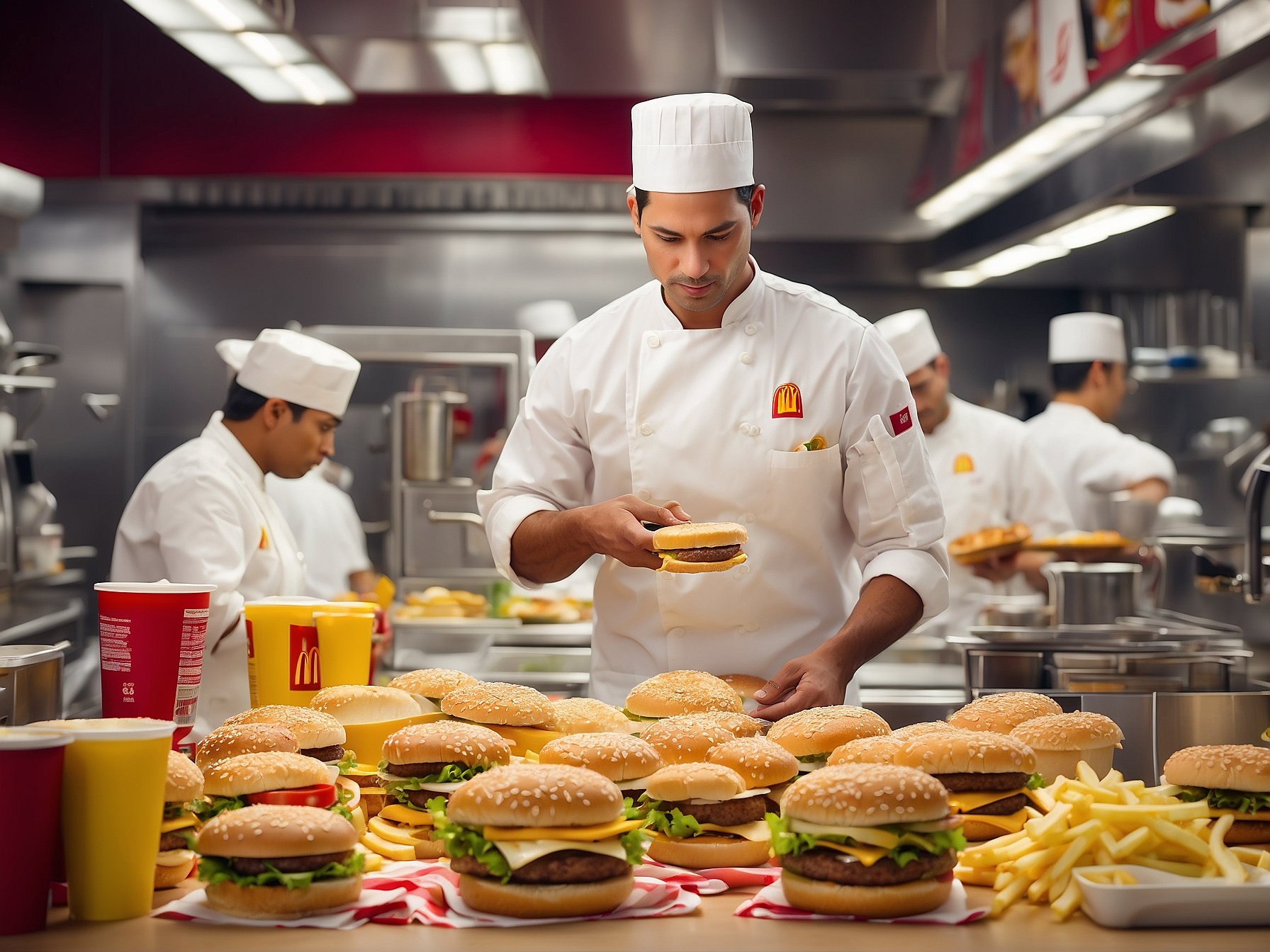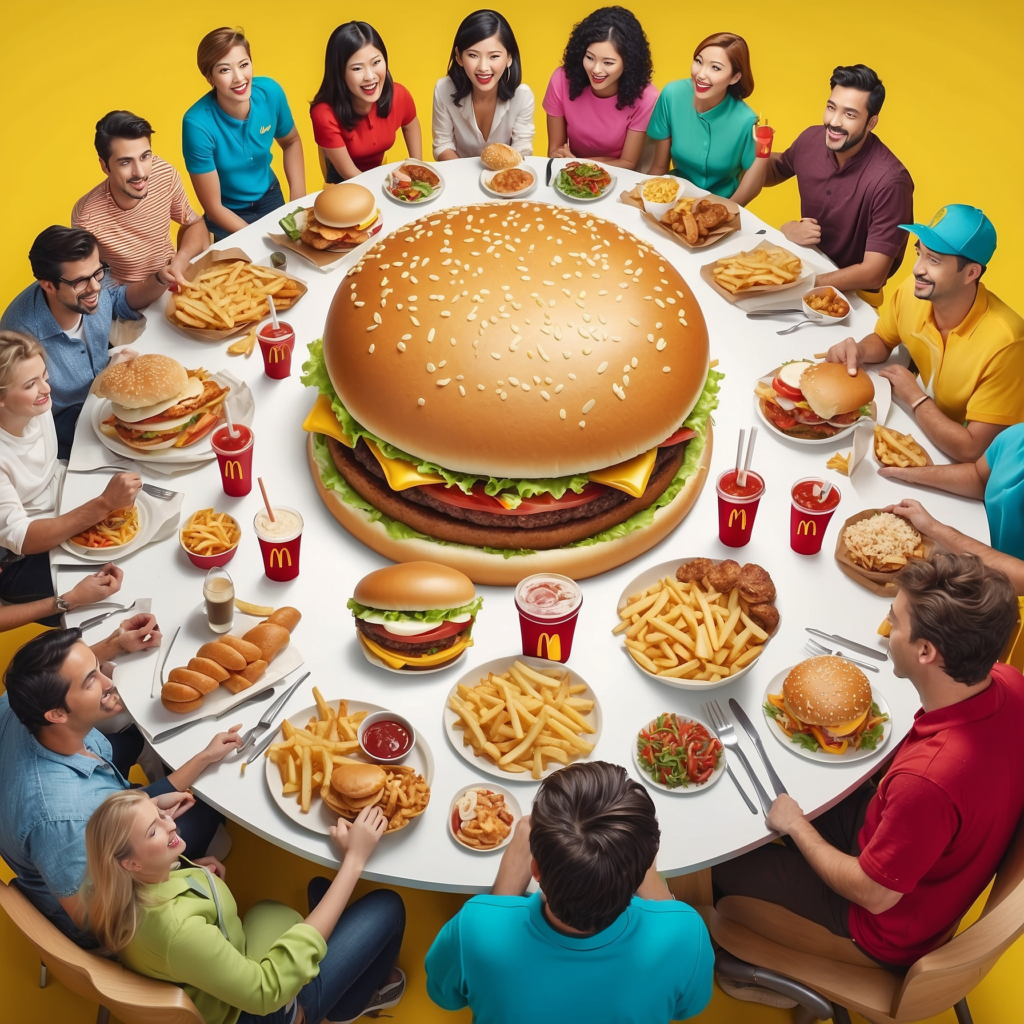For any business to thrive and stand out in the business space, it must have some distinctive features that differentiate it from similar businesses and make it outrightly unique. This is generally referred to as a company’s competitive advantage.
McDonald’s competitive advantages have kept it at the top of the fast-food empire for over 70 years. When you’re consistently named—for 15 years in a row—among the world’s top 10 most valuable brands, you know you’re doing something right!
Behind those Big Macs and McFlurries is a business strategy that’s as finely tuned as a Swiss watch; making the Golden Arches giant unique in the buzzing fast-food world.

Buckle up! McDonald’s isn’t the only fish in the fast-food sea. Facing off against burger behemoths like Burger King, KFC, Wendy’s, Subway, Domino’s Pizza, Chipotle, and even coffee king Starbucks!
And there’s more: Popeyes, Pizza Hut, Tim Hortons, Costa Coffee, and Papa John’s Pizza. Even Panera Bread, Jack in the Box, Arby’s, Pret a Manger, Sbarro, Hungry Jack’s, and Nordsee want a bite of the burger pie. The fast-food industry is a crowded kitchen!
Michael E. Porter discussed the concept of competitive strategy in his 1980 book, Competitive Strategy. He outlined the game plan and McDonald’s took notes.
The 3 generic competitive strategies include:
This requires efficient business management practices that are geared toward cost reduction. It includes:
When cost is reduced in the above areas, a company can offer its products or services at a cheaper rate relative to its competitors. Although the lower pricing of goods and services often means the profit per unit of product or service is minimal, the company can still maintain profitability by selling in larger quantities.
This is possible when the company can offer a product or service of good quality compared to its competitors. The brand’s ability to source raw materials cheaply is also a major contributor to using overall cost leadership as a competitive strategy.
The overall cost leadership is the major competitive strategy used by McDonald’s. Right from its inception in 1948, McDonald’s founders, Maurice and Ronald McDonald focused on keeping the cost of their products low while maintaining quality and standards. More on this later.
Differentiation involves offering a unique product or service within your industry. Depending on its implementation, differentiation can take different forms. When differentiation is used as a competitive strategy, it often guarantees above-average returns for the company. This is because it gives a sense of exclusivity for the product or service.
Still confused? Read this detailed article on the nitty-gritty of differentiation.
McDonald’s has mastered differentiation, it isn’t just another burger joint. Their secret? Unique, tasty meals that keep changing with regions, seasons, and even time-based offers. It’s this strategy that keeps the McFaithful coming back for more and makes life harder for the copycats.
Ask for a McAloo Tikki when next you visit the Golden Arches—trust us, it’s worth it.
Are you building a business too? Here’s how YOU can differentiate even better…
I made a free eBook called 8D Framework to Launch Your Business. It’s a step-by-step guide designed to teach you all the business basics you need to go from zero to having a fully launched product or service.
It’s literal gold because it contains everything from product building, to marketing, sales, finance, and much, much more… You can check it out here:
Focus is another competitive strategy used by companies to gain a competitive advantage. It involves focusing on a geographic market, a segment of the product line (specialization), or selling your product or service to a particular market segment mostly through demographic marketing.
Using focus as a competitive strategy entails streamlining a company’s operation to tackle a defined portion of the market. This rests on the premise that a company is better able to serve its narrow strategic target more effectively or efficiently than competitors who are competing more broadly. Through focusing, a company achieves differentiation by better meeting the needs of the particular target, lowering costs in serving this target, or both.
McDonald’s selectively uses this competitive strategy by targeting specific market slices and tailoring their offerings. Whether it’s vegetarian meals in India or halal bites in the Middle East, McD’s knows its crowds.
McDonald’s competitive strategy of overall cost leadership gives them the competitive advantage of having more customers due to the combination of high food quality and cheap pricing. After all, everyone wants good food, and how much better when it’s cheap too?
High-quality food at low prices? The competition just can’t keep up. With its global footprint, McDonald’s market share would make a real estate mogul blush. They dominate, plain and simple.
McDonald’s has maintained cost leadership over the years through 3 main ways:

You can’t argue with numbers: US$25.49 billion in revenue in 2023, serving 69 million customers daily across 41,000 locations. How’s that for global market leadership? Check out the brand’s competitive advantages:
One of the competitive advantages of McDonald’s is the brand’s strategic partnerships with other industry leaders. Crocs are the rave of the moment and everyone has a pair or two; McDonald’s has keyed in on this rave by… guess? Having Cros Happy Meal! This meal comes complete with 8 exclusive Crocs clips along with a special Jibbitz sticker sheet for you to create your own unique Crocs.
From time to time, the brand launches collectibles that customers can access through their outlets. This summer (August 2024), the brand launched the Collector’s Edition cups, which showcase iconic moments from the brand or its partners, such as the Grimace Mug in 1976, Pet Lovin’ Barbie in 1999, and Shrek from ‘Shrek the Third’ in 2007. Hurry and build up your collection, mate!
Suppose you are not an outdoorsy person, and would rather enjoy your french fries on your sofa; McDelivery is your jam. Seamless ordering through the app and delivered right to your couch thanks to partnerships with Uber Eats, Grubhub, and DoorDash.
You can also enjoy special offers when you purchase in the app. Example? The $5 meal plan which was introduced in the summer but has been extended to fall due to the resounding success of the campaign.
Several other unique collaborations such as those with Show Up and Show Out in Black, JUJUTSU KAISEN, Squishmallows Happy Meal, Spotlight Dorado, WcDonald’s, and many others.
All these are aimed at creating a more robust consumer experience and add to McDonald’s competitive advantages by sustaining the loyalty of its customers.
Special offers, unique collabs—McDonald’s does it all, and wins every time.
If you’re a fan of eating out regularly, a consistent and reliable customer experience will definitely be a big deal for you because you don’t want to order your fav McNuggets and get served nuggets that taste different every other day.
McDonald’s understands the importance of giving its customers a consistent and reliable experience with every meal, carving a niche for itself by substantially offering a fairly uniform menu through standardization of ingredients and preparation methods.
Menu standardization makes it easier to train staff and ensure consistency gives you that assurance of entering any of the brand’s outlets with confidence and ordering your fav item on the menu. Uniform menu items and standardized operations mean you get the same Big Mac, anywhere, anytime. Those fries? They’re cooked to a precise temperature and time. Every. Single. Time.
The consistency of the menu and service to consumers has helped to build a strong brand and customer loyalty. Consistent and reliable customer experience as McDonald’s competitive advantage is closely related to the focused competitive strategy.
Consistency makes McDonald’s a brand you trust.
McDonald’s knows that for a lot of folks, price is king. But here’s the thing: they don’t just offer cheap eats. They make sure they’re profitably cheap. The sale of the company’s products at competitively cheap prices is its key competitive advantage. The low pricing is partly attributed to the company’s active involvement in its supply chain process through the vertical integration of some of its operations.
McDonald’s currently exists in over 119 countries with over 41,000 outlets and serves over 69 million individuals daily. This largeness of the business means that it has ongoing supplier relationships with a wide network of suppliers that provide food ingredients, packaging, equipment, and other goods at comparatively lesser costs due to the large volume of purchases.
McDonald’s has also proven over its decades of operations that it is also concerned with the taste, nutrition, and quality of the products on its menu. The brand provides nutritional information on the food it serves. It also has a Food Safety Advisory Council, composed of the Company’s internal food safety experts, its ingredients suppliers, and academics. These provide the company with the necessary insight into food safety and quality.
McDonald’s establishes and enforces high food safety and quality standards by maintaining food studios and quality centers around the world which are equipped to promote the consistency of high food quality and standards. This involves third-party verifications, ongoing product reviews, and virtual supplier visits.
The company has ongoing programs to educate and equip its employees about food safety practices such as proper storage, handling, and preparation of food. It also organizes training on best practices for food safety and quality for its suppliers and restaurant operators.
These efforts are paying off positively because during third-party food safety and quality audits of over 250 distribution centers in 2023, over 98% of these centers were found operating consistently with the McDonald’s Distributor Quality Management Process (DQMP) audit standard.
McDonald’s competitive advantage of cheap pricing is an offspring of its overall cost leadership strategy. This has made it possible for some menu items to still sell for as low as $1 despite the rising cost of food ingredients globally. The cheap pricing further aids the company’s profitability because a larger population can comfortably patronize the brand; facilitating McDonald’s attainment of market leadership.
During the 2007/2008 economic downturn, while other fast-food chains floundered, McDonald’s saw a revenue increase from $20.895 million in 2006 to $22.787 million and $23.522 million in 2007 and 2008 respectively. Cheap prices, even in hard times, make McDonald’s unbeatable.
Cheap, tasty, nutritious—McDonald’s defies the odds with their low prices.
What is a multi-billion dollar company without a global presence? Unimaginable, right? McDonald’s isn’t just in your town; it’s in practically every corner of the globe . Currently, the company operates over 119 outlets worldwide. But expanding globally isn’t as easy as just slapping up a Golden Arches sign and calling it a day.
McDonald’s global presence has been achieved through a combination of different approaches including partnerships with local restaurants, franchising, licensing, and joint ventures. These people already understand the market, ensuring smooth operations.
The overall cost leadership competitive strategy is also of importance here. This is because as the company expands to new locations, it still maintains its model of reducing production costs and cheap pricing of its food.
Cheap pricing is one of the foremost pricing strategies that aid market penetration. It also attracts new customers as the Golden Arches is likely to be the cheapest place in town, attracting price-sensitive individuals. This by extension also expands the brand’s ability to generate more revenue through increased sales.
Another way McDonald’s competitive advantage gives it an edge and aids in its global presence is through its distribution agreements with retail giants such as Walmart. The agreement between the fast-food chain and the multinational retailer means customers can access McDonald’s products through Walmart retail stores.
McDonald’s global presence further strengthens its brand and enhances its reputation as a market leader in the fast-food business. These are significant drivers of its competitive advantage in the industry making it widely recognized as one of the most iconic and successful fast-food chains worldwide.
McDonald’s is not just a master at market penetration, they are also the king of customer retention in the fast-food industry.
Variety is the spice of life and McDonald’s is the master chef. Variation is seen both in the kinds of restaurants and the meals offered.
For restaurants, McDonald’s operates several kinds including sit-ins, drive-thrus, and self-service kiosks. This variation ensures that the company caters to a wide range of consumers. They even went further by offering food delivery options that customers who would rather have their meals delivered to their preferred location can use. McDonald’s is all about making it easy and fast for you to give them your money.
McDonald’s gains an additional competitive advantage by tweaking its menu to suit the geographical distinction and preferences of its customer base. For instance, the brand does not serve beef in its Indian outlets and does not serve pork in the Middle East.

It has further introduced several vegan offerings such as the McPlant burger, Vegetable Deluxe, Veggie Dippers, and Millionaire’s Donut to cater to its increasing vegetarian consumers. This availability of variation gives McDonald’s a competitive advantage over fast-food chains that only serve a standardized menu without making room for variations.
Why choose McDonald’s over another fast-food chain? High-quality standards, unique taste, cheap pricing, and variety. Oh, and they’re tech-savvy too.
McDonald’s has partnered with Google Cloud to apply generative AI across several key business priorities to power exciting new experiences for McDonald’s employees and customers. This has been deployed through digital menu boards, faster online ordering, optimizing self-service kiosks, and several other applications that are still unfolding.
All these combine to give McDonald’s a competitive advantage in the fast-food industry.
McDonald’s has built an empire on convenience, value for money, and a consistent customer experience, aiding it in attracting and maintaining a loyal customer base globally. Their cost leadership strategy ensures they stay on top, despite growing competition.
The brand adopted cost leadership as its unique selling point (USP) and competitive strategy. Its success isn’t just about burgers and fries. It’s about smart strategies, efficient operations, and a deep understanding of their customers.
As a small or medium business, you should analyze your business alongside the 3 competitive strategies and choose the strategy that best fits the product or service you are offering.
Go forth and conquer the business world, my friend. And if you ever need inspiration, just remember: even a small business can have Big Mac dreams.

Email subscription is available ONLY TODAY (oh, okay, and tomorrow).
Surely, we respect your inbox! Unsubscription works every day.

We’d love to tailor your experience — which of these best describes you?